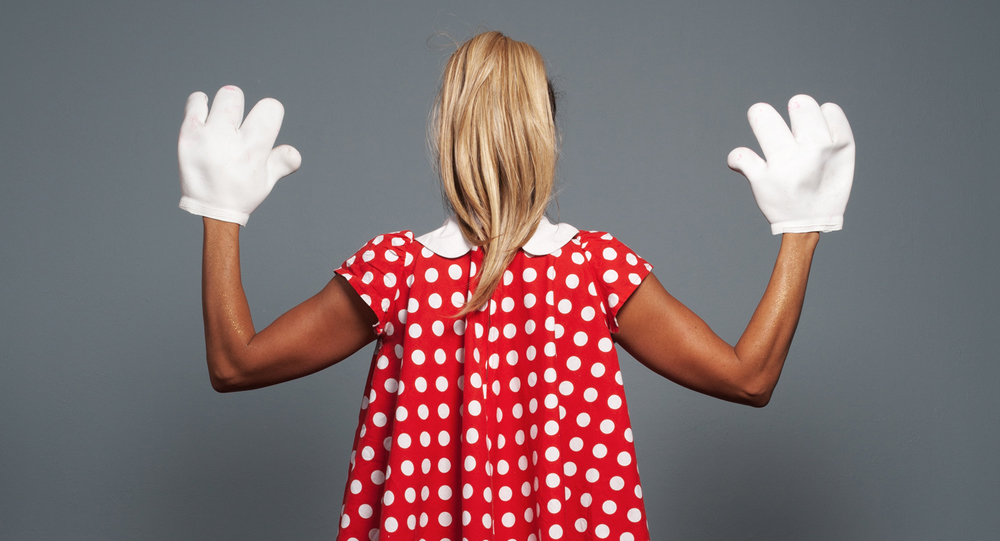Provocateuse Adrienne Truscott brings her wickedly funny new work to MIT.
One of the best anecdotes in Adrienne Truscott’s delightedly vulgar, rampantly feminist, genre-shifting solo-show THIS is about a toilet. Specifically, it’s about a toilet in a camper in a parking lot in Brooklyn, where Truscott and her boyfriend were living in what she calls an “experiment in affording life as an artist in the city.”
Since the camping loo didn’t connect to the city’s water-mains, Truscott and her boyfriend needed to take turns emptying their facility—smuggling the goods out in a briefcase and into friends’ bathrooms, workplace stalls and restaurant lavatories. There are still several punchlines yet to go in this story, which I wouldn’t dream of spoiling, but there’s a fertile metaphor hidden in Truscott’s little confession. If you put your crap in a respectable container, you can carry it anywhere.
Truscott is bringing THIS to MIT from February 7–9 as the second-ever offering in the MIT Performing series. And on the outside, it looks totally respectable. Truscott is a much-beloved creator, an Obie and Bessie Award winner (as a founding member of the all-woman LAVA dance/circus company), a major influencer on the international circuit (thanks to extraordinary highs and lows at Edinburgh Festival) and—despite making recent pieces that look like very arty stand-up comedy—an acclaimed visionary in the world of contemporary dance.
Truscott’s certainly gotten a name for being transgressive, particularly with her game-changing 2016 piece Adrienne Truscott’s Asking for It: A One Lady Rape About Comedy Starring Her Pussy and Nothing Else! that defiantly reclaimed the “rape joke”—and then buried it. But in THIS, Truscott stays mostly clothed, and the show’s title can even be printed in a family magazine. It seems so safe all of a sudden.
Yet the project in THIS is subversive in its own way. It uses comedy to approach quite serious things like “why do we tell stories about ourselves,” and “will it cure us if we can we turn betrayal into a joke.” The piece is so raw, you can watch Truscott reacting to it even as she performs it. There are turns towards the deeply personal in it, that the performer seems to recoil from it like a hot stove—she’ll tell us something brutally honest about her family life, then snort at herself. “Gross!” she’ll say and roll her eyes.
Truscott is keenly aware of the strangeness of the work—noting that it was sort of a piece that wasn’t supposed to exist. “THIS was made under fairly intense time circumstances,” she says. “That’s why it’s called what it’s called. I was working on this huge project that fell through and I had to make a different piece for the hole that was left! I kept joking that ‘I’m doing THIS for the money.’ So it was made in the heat of—and thus is about—making a piece with the financial creative economy of being an independent artist.”
Settling what THIS is takes up a lot of the play’s real estate—and its development. “I often only learn that kind of thing after I perform the piece and witness what I made,” she says. In this case, the work became a memoir…at least the kind of memoir where the performance artist wears horse’s hooves while pretending to play the piano.
Frantic for content, Truscott started looking in folders on her computer that weren’t meant for performance. “A lot of the text was stuff I’d actually intended for the page,” says Truscott. Because she was short-circuiting her usual dance-led process, new and sometimes frightening things bubbled up.
“Usually,” she says, “I only really feel creative if I’m moving. Stillness and calm don’t trigger creativity—whether I’m in a studio, or even on a train, movement is connected to production for me. Yet writing is clearly related to analysis and memory. When I write, I remember things I didn’t know I didn’t remember. I noticed that. I know now that as a person with considerable trauma in my body, there’s a lot that I don’t recall, and writing makes me find details that I’d lost.”
In her MIT performances, Truscott will demonstrate not only that kind of radical excavation but also how to turn linear experience (biography) into nonlinear art. She describes her process as inextricably linked to choreographic composition. “Even when I’m writing with a construct in mind,” Truscott says, “language itself becomes repetition, or the evolution of a phrase”—just as action does for postmodern dancemakers.
While at MIT, Truscott will, as she does whenever she performs on a campus, conduct talkbacks. “If audiences know I’m available to be challenged and interrogated, it makes them more receptive to what I’m doing,” she says with her raspy laugh. So go, and be receptive. Receive heart from her work, and delight and wisdom.
Just don’t touch the briefcase.
____________________
Reserve seats to THIS by Adrienne Truscott, part of the MIT Performing series
February 7-9, 2019 / 8:00pm
MIT Theater Building W97, 345 Vassar Street, Cambridge, MA


